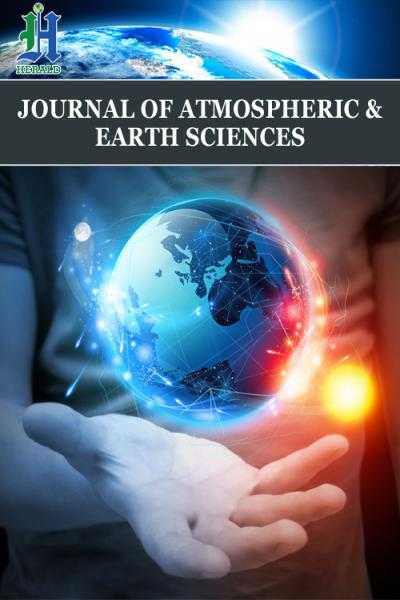
Finite Element Modeling of Earth and Earthquakes from Gravitational Waves
*Corresponding Author(s):
Rao JSThe Vibration Institute Of India, Bangalore, India
Tel:+91 9845346503,
Email:rao_js@yahoo.com
Abstract
The earth has seen continental drift and plates like Indian from Gondwanaland collided with Asian plate causing Himalaya Mountains. Wegener’s theory was accepted after his death but the cause of drift was not established. The push from gravitational waves on the earth is the only likely force that could have caused this drift over millions of years of the earth’s history. These earthquakes from the plate movements seem to coincide with the ecliptic position when they occur while the gravitational waves pass across at light speed across the pale blue dot of earth in space.
The macro earth is modeled by finite elements and subjected to the strains as measured in US Laser Interferometry Gravitational Observatories in 2015 for the first time. The power input from the gravitational waves to the earth is obtained. The three earthquakes reported in August 2016 that occurred almost simultaneously are noted to fall on the ecliptic around that time and one particular quake between Pakistan-Afghanistan borders is presented in detail. The problem of crack initiation and propagation as in metallic structures due to excessive strain is presented that could result in this earth phenomenon.
Keywords
Finite Element Modeling of Earth; Earthquakes; Gravitational Waves
BACKGROUND OF GRAVITATIONAL WAVES
Einstein [2,3] presented his theory of Relativity: The Special and General Theory. Gravity according to Einstein is distortion in the fabric of Space and time; Matter tells space how to curve; space tells how matter should move. For example as two black holes merge and the energy released, it will emanate ripples of energy more than that of all put together in all stars of this universe in a quick fraction of a second. These gravitational waves, travel at light speed of across the Universe. Matter and energy are two expressions of a single material. We can think of space time as a fabric; the presence of large amounts of mass or energy distorts space time causing the fabric to warp. This warpage is gravity.
Einstein introduced gravitational waves that communicate information between two colliding objects (Newton didn’t provide this) about a century ago. This is a problem of action at a distance. Newton looked at gravity as a force proportional to mass of the bodies and inversely proportional to the square of the distance of separation. Einstein looked at the bodies’ influence on the space they are embedded in. The massive body makes a depression in space time fabric around it and enables other body follow its natural path to be attracted to this depression. The Newtonian and Einstein approaches give the same answer when Earth rotates around Sun or Moon rotates around the Earth or as the case of classical Apple falling to Earth. Figure 1 shows the Sun and Earth with its space time fabric, the earth orbits the Sun following the curvature of the local space in the vicinity of the Sun. Einstein’s theory provides for a traffic police man or a signal to inform the traffic movement of cosmic bodies either at speeds below the speed of light as within the solar system of figure 1, or in an expanding universe.
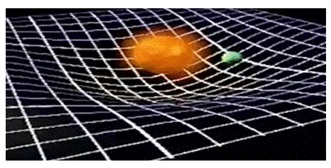 Figure 1: Sun and Earth in space time fabric of Sun.
Figure 1: Sun and Earth in space time fabric of Sun.The two approaches differ in the case of a very rapid collision, e.g., two stars colliding or a star exploding, Einstein provided in his relativity approach, the transfer of information on the changes in mass distribution and the presence or absence of the stars to the whole Universe. The Universe is full of trillions of stars in each galaxy and there are several trillions of galaxies. In ever expanding universe some of these stars or black holes eventually collide that takes place almost continuously.
These colliding waves take energy into space through gravitational waves. They are ripples in the curvature of space time which propagate as waves, travelling outward from the source (Figure 2). They transport energy as gravitational radiation; just as a boat sailing through the ocean produces waves in the water, moving masses like stars or black holes produce gravitational waves in the fabric of space time. A more massive moving object will produce more powerful waves, and objects that move very quickly will produce more waves over a certain time period. They pass through the earth continuously.
 Figure 2: Gravitational waves that communicate information across space time.
Figure 2: Gravitational waves that communicate information across space time.The two Ligo detectors detected second time within three months on Christmas day December 25, 2015 gravitational waves from the inspiral, as the decaying mutual orbits of two bodies and merger of two black holes [9], one was 8 and the other 14 times the Sun’s mass, merging to form a black hole with 21 solar masses. This was announced on 16th June 2016.
It is worthwhile to note that several minor earthquakes were reported, see Earthquake report [10] in India, Indonesia, Afghanistan, China, Guam, USA almost at the same UTC, on the day when gravitational waves were measured on 14th September 2015. Also several earthquakes were reported on 25thDecember 2015 in Ashkasham (Eshkashem), Afghanistan, Muzaffarabad, Pakistan (Figure 3) on the day of reported second measurement. Last year in 2017, the third Ligo Virgo in Italy began operating and measured third gravitational waves on August 14, when two black holes merged 1.8 billion light-years away, their violent union sent shock waves through space, time and Earthquake report 14th August 2017 with the quakes in Pacific-Antarctic region amongst others; there were two significant earthquakes that were of magnitude 5 amongst several minor ones [11]. A fourth gravitational wave has been detected from the same Ligo on Sep 27, 2017 [12]. On the same day earth quake reports were given in Indonesia and New Zealand amongst others [13].
 Figure 3: Earthquake on Christmas day 2015 in Afghanistan.
Figure 3: Earthquake on Christmas day 2015 in Afghanistan.The relevance of gravitational waves was quite obvious the missing and convincing energy required for continental drift theory as pronounced by Wegner is from the collision of cosmic bodies and expanding universe [14,15]. The slow drifting of the continents over hundreds of millions years is with the help of the energy passed on by gravitational waves. This continuing drift of continental plates is the main reason for earth quakes caused by one plate jutting against another plate and forming mountains such as Himalayas in this process. This paper deals with the energy received by earth from the measurements of Ligos resulting in earthquakes.
GRAVITATIONAL WAVES FROM SOUTHERN CELESTIAL HEMISPHERE
If one interprets the red shift as due to motion, Hubble's Law can be restated in its familiar form as shown in figure 4. However the red shift measured for distant galaxies is primarily due to the expansion of the universe, and not to what are called peculiar velocities. An approximation to the red shift driven by the expansion of the universe is found to be v ~ cz when v is much smaller than cz or in figure 4a, where, c is the speed of light, 300,000 kilometers per second. The distant objects move away faster as in figure 4b. This shows that the distant objects after collision are not visible in an expanding universe when the gravitational waves travel opposite to the expansion direction. Wall reports that the universe is expanding 5 to 9 % faster than thought earlier [17].
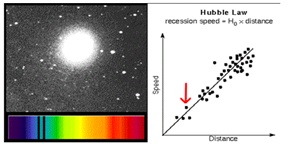 Figure 4a: Recession speed is lower when the object is closer.
Figure 4a: Recession speed is lower when the object is closer.Figure 4b: Recession speed is higher when the object is far away.
EARTH’S PATH AROUND THE SUN IN SPACE - ECLIPTIC
The earth’s path around the Sun, the ecliptic is shown in figure 5, [18,19] The north and south ecliptic poles normal to the ecliptic are shown in the celestial sphere. The celestial equator and the north celestial and south celestial poles normal to this are also given in figure 5. The ecliptic makes an angle 23.4o with the celestial equator, i.e., the ecliptic poles make an angle 23.4o with celestial poles. The equinoxes are the intersection points of the ecliptic and celestial equator. The vernal and autumnal equinoxes are marked in figure 5.
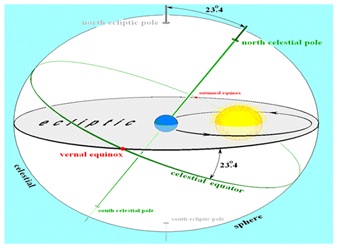 Figure 5: Ecliptic.
Figure 5: Ecliptic.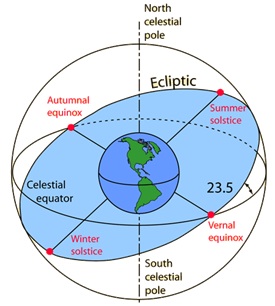 Figure 6: Ecliptic in march equinox.
Figure 6: Ecliptic in march equinox.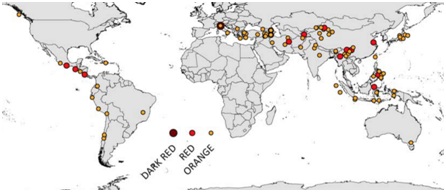 Figure 7: Earthquakes in 2012.
Figure 7: Earthquakes in 2012.FINITE ELEMENT MODEL OF MACRO EARTH
An earthquake occurs with an epicenter around the geometry of the earth, just like a metallic structure fails in fatigue with peak stress exceeding local strains that go into plastic region [24]. Therefore a finite element model is built to study the topography around the epicenter of an earthquake.
The strain recorded in Hanford, Washington and Livingstone, Louisiana Ligos on 14th September 2015 is shown in figure 8. This means amplitude of 10-21 strain acted on the earth for a period of 0.05 seconds due to passing of the gravitational waves at speed of light. The amount of energy passed by the gravitational waves to the earth can be determined from today’s technological advances of Simulation Based Engineering Science [25,26]. Though Earth is a tiny dot in space, it is big or macro size for the humans. No one made a finite element model of this huge earth and it is necessary to make this model to determine the influence of such a small strain that can cause disaster for the macro size earth. The way in which such a model is worked out is given below.
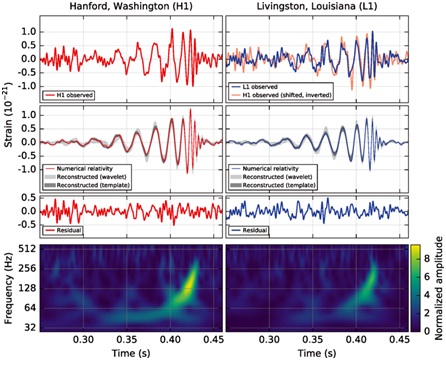 Figure 8: Strain records and frequency as a function of time on 14th September 2015.
Figure 8: Strain records and frequency as a function of time on 14th September 2015.• Earth Radius 6.371 million m
• The Crust + Oceans form the Outer Layer of comparatively negligible thickness
• The Mantle Radius 3.472 million m
• Hot Iron Core Radius: 3.374 million m
• Earth’s Mass 5.972 × 1024 kg with a mean density of 5514 kg/m3
• Black-body temperature 254.0 K
• Avg Poisson’s ratio 0.25
• The top of the mantle is 870° C; towards the bottom, temperature is about 2,200-3,700° C
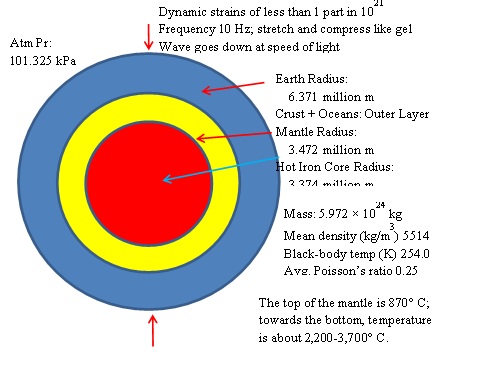 Figure 9: Full scale model of earth.
Figure 9: Full scale model of earth.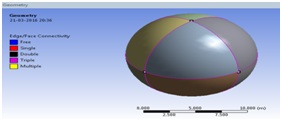 Figure 10: Scaled model of Earth by a million.
Figure 10: Scaled model of Earth by a million.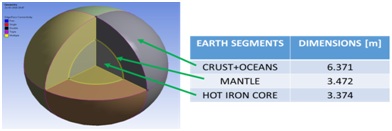 Figure 11: Scaled Model with its segments.
Figure 11: Scaled Model with its segments.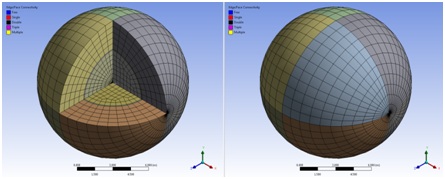 Figure 12: Finite element model of scaled-down Earth.
Figure 12: Finite element model of scaled-down Earth.Consider the original model to be height x and thickness y and z in width. Let the strain applied be equal toe. The strain energy V for one dimensional model is

In the original model the strain energy is proportional to and the scaled down model the strain energy is where ef is the strain factor to give the same strain energy in both the models.


We need Young’s Modulus E for determining the strain energy in equation (1). The earth is a complex anisotropic body, for simplicity it is assumed to be = 200 GPa. The results obtained for the strain energy are shown in figure 13. The total strain energy is obtained by integrating over all the elements and shown in figure 14.
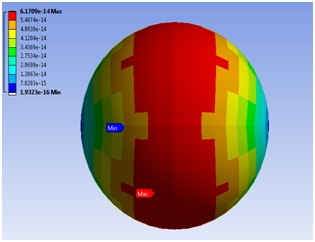 Figure 13: Strain energy plot of the earth.
Figure 13: Strain energy plot of the earth.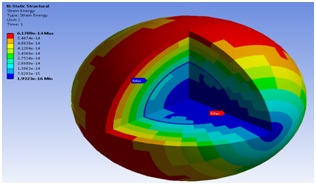 Figure 14: Strain energy integrated.
Figure 14: Strain energy integrated.HIMALAYAS AND EARTHQUAKE ON 16TH APRIL 2016
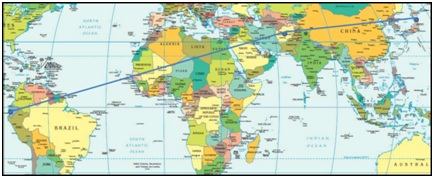 Figure 15: Earth Quakes that occurred on 16th April 2016 with epicenters falling on a circle close to the ecliptic of March-April.
Figure 15: Earth Quakes that occurred on 16th April 2016 with epicenters falling on a circle close to the ecliptic of March-April.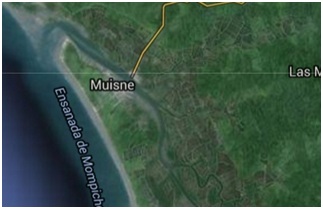 Figure 16: The earthquake with magnitude 7.8 near Esmeraldas, Ecuador.
Figure 16: The earthquake with magnitude 7.8 near Esmeraldas, Ecuador.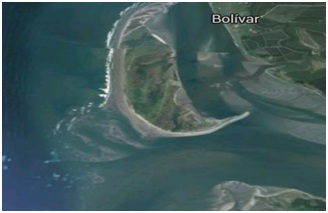 Figure 17: Epicenter location around bolivar.
Figure 17: Epicenter location around bolivar.Similarly an earth quake of 4.6 magnitude occurred in region of Afghanistan-Pakistan border 70 km from P?r?n, N?rest?n, on the same day, April 16, 2016 at 02:10 AM as shown in figures 18 (a,b) shows the steep mountainous area with the river in the gorge where the earthquake epicenter lay. The magnitude of earth quake is smaller here as the discontinuity is somewhat smoother in figure 18.
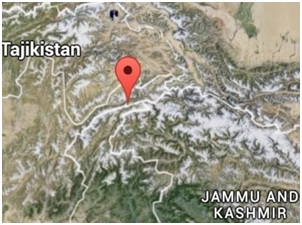 Figure 18: Afghanistan earth quake.
Figure 18: Afghanistan earth quake.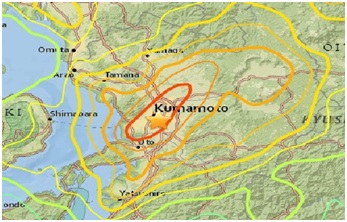 Figure 19: Kumamoto prefecture earth quake.
Figure 19: Kumamoto prefecture earth quake.The gravitational waves coming from the southern hemisphere have also been responsible to break up Pangaea nearly 300 million years and bring the earth’s continents to the present positions. It may be noted that orogeny from volcanoes is a different geological phenomenon altogether. The volcanoes provide the required energy for the earth to suffer a quake.
EARTHQUAKES ON 24TH AUGUST 2016
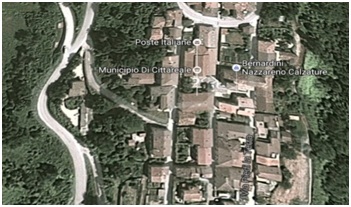 Figure 20: Cittareale, Latium, Italy.
Figure 20: Cittareale, Latium, Italy.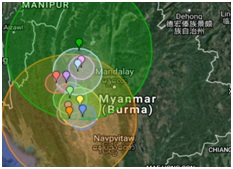 Figure 21: Chauk, Megway, Myanmar.
Figure 21: Chauk, Megway, Myanmar.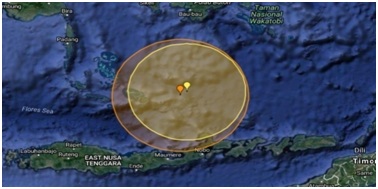 Figure 22: Maumere, East Nusa Tenggara, Indonesia.
Figure 22: Maumere, East Nusa Tenggara, Indonesia.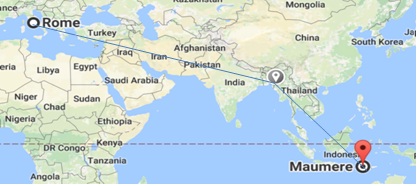 Figure 23: Three earthquakes on 24th august 2016 and their locations.
Figure 23: Three earthquakes on 24th august 2016 and their locations.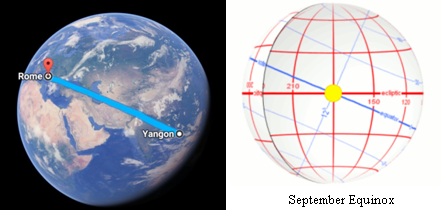 Figure 24: Ecliptic in September equinox.
Figure 24: Ecliptic in September equinox.STRAIN CONCENTRATION FACTOR AND CAUSE OF EARTHQUAKES
A typical example is a turbine blade with a discontinuity in the geometry where a crack can initiate because stress raiser exists here. This is shown in figure 25 with a sector of the disk with one blade using cyclic symmetry boundary conditions applied on both the partition surfaces. The common nodes on the pressure faces where the load transfer between blade and disc takes place are joined together to make it as a single entity.
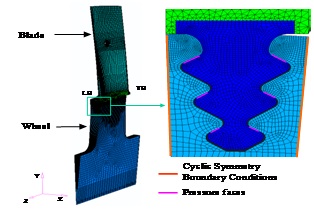 Figure 25: Bladed disk model showing the fe mesh.
Figure 25: Bladed disk model showing the fe mesh.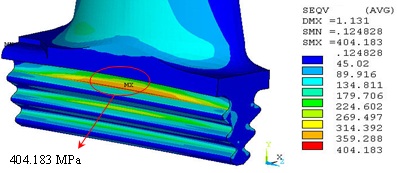 Figure 26: Von mises stress distribution.
Figure 26: Von mises stress distribution.
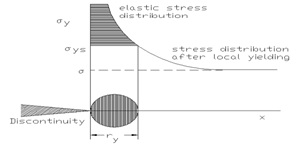 Figure 27: Crack tip plastic zone.
Figure 27: Crack tip plastic zone.Theoretically at crack tip, the stress is infinity, even though the stress field is grossly elastic. There is a small plastic zone close next to the discontinuity like a notch or a crack, surrounded by an elastic zone as in figure 27. Neuber has shown that at a discontinuity when the stress is in the plastic region one has to determine the theoretical stress concentration factor by recognizing that strain concentration exists [29]. The crack tip stress can then be determined by using the surrounding elastic fields.

Though the geometry is not known, the approach can be outlined here. We take figure 18b to propose the model here in figure 28. A cross-section A-A looking from right is given in figure 29.
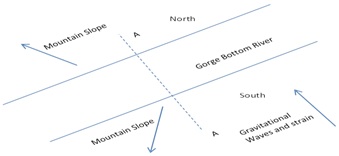 Figure 28: Plan view of figure 18b.
Figure 28: Plan view of figure 18b.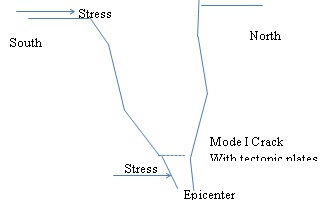 Figure 29: Section a-a looking from right.
Figure 29: Section a-a looking from right.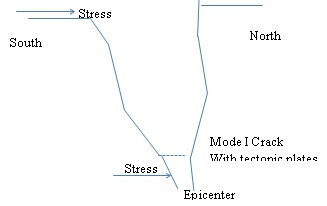 Figure 30: Earthquake topography looks similar to a turbine blade notch in figure 5.
Figure 30: Earthquake topography looks similar to a turbine blade notch in figure 5.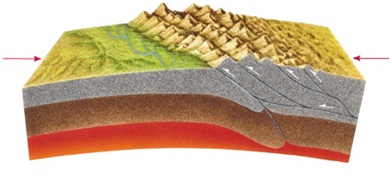 Figure 31: Himalayan overlapping thrust faults.
Figure 31: Himalayan overlapping thrust faults.Generally cracks propagate in what is called Mode I, once the threshold value for propagation is reached. Comparing figures 26 and 30, as in figure 32, we can say that the crack opens in Mode I whenever there is a thrust from the gravitational waves.
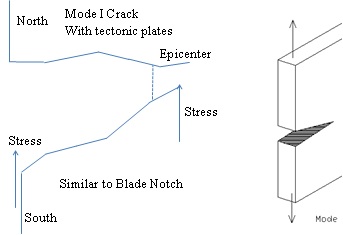 Figure 32: Himalayan thrust faults open in mode I.
Figure 32: Himalayan thrust faults open in mode I.We have no clear information on the crack tip in the case of earth quakes in the tectonic plates under thrust faults; however given the huge sizes in figures 28 and 31, we can see that large stresses are produced under the thrust from gravitational waves such as those occurred on April 16. Under this oscillating thrust force, as measured in a Ligo in figure 8, the tectonic plates move further suddenly, causing an earth quake.
It will be interesting to work on a relation between the depth of Earthquake and strain value once it is measured or available in a Ligo measurement through simulation as shown in figure 30. However we need the measured topography of the landscape as in figure 18, which is not available currently.
CONCLUSION
• Gravitational waves emanating from southern celestial hemisphere go pass at the speed of light transferring some energy to the earth almost continuously, some of them strong and some weak
• The gravitational waves pass the earth in a direction normal to the ecliptic which periodically varies every year
• This energy is probably responsible for continental drift over hundreds of million years of the existence of earth in the universe. The missing part of the cause of continental drift in Wegener’s theory can be now attributed to the gravitational waves. This may yet have to be mathematically proven by computational fluid dynamics of the continents like Gondwanaland over the mantle, just like sailing ships over the oceans. Geologists and Engineers have to work together in generating the required data for this purpose
• The continental drift is known to have generated movement of continental plates jutting over other plates creating mountains such as Himalayas causing earthquakes
• There have been four instances of gravitational waves and at all these times earthquakes have been reported giving rise to speculation that it is the energy from gravitational waves that is responsible to generate the earthquakes
• Whenever strong earthquakes are reported they are falling on the mountains on the ecliptic position at that time of the year, attributing to the fact that it is gravitational waves that are causing earthquakes
• The earthquake is compared to fracture in metallic structures and strain intensity factor at the discontinuity or notch that generates stresses a little above the fracture toughness of the material. The required earth properties in the vicinity of earthquake prone mountains are to be established for appropriate simulation of crack propagation (or earthquake) and clear analysis is to be accomplished to provide computational methods for study of earthquakes
• Collaboration between Astrophysicists, Earth Scientists and Engineers is necessary to accomplish such of these multi-physics tasks
ACKNOWLEDGEMENT
REFERENCES
- Weddington D (2014) Principia Mathematica - Newton's Principia. Earl Gregg Swem Library, College of William & Mary, Virginia, USA.
- Einstein A (1917) Kosmologische Betrachtungen zur allgemeinen Relativitätstheorie. Sitzungsberichte der Königlich Preußischen Akademie der Wissenschaften (Berlin), Berlin, Germany. 1: 142-152.
- Einstein A (1920) Relativity: The Special and General Theory. Methuen & Co Ltd, London, UK.
- Reitze D (2016) ‘We did it!’ Scientists announce discovery of gravitational waves-video. Guardian News and Media Ltd., UK.
- Livingston DM (1974) The Master of Light: A Biography of Albert A. Michelson. Physics Today 27: 54.
- Chu J (2016) Q&A: Rainer Weiss MIT physicist developed the concept for LIGO as a teaching exercise, MIT News Office, USA.
- Thorne K, Weiss R (2016) A brief History of LIGO. Caltech, California, USA.
- Vervaeck A (2015) Earthquakes in the world on September 14 , 2015 (M2.9 or more). Earthquake-Report, USA
- Cole B (2016) Ligo has Detected Gravitational Waves for the Second Time. Wired, USA.
- Vervaeck A (2015) Very Strong earthquake - Ashkasham, Afghanistan on December 25, 2015. Earthquake-Report, USA.
- Volcano Discoveries (2017) Earthquake report world-wide for Monday, 14 Aug 2017. Earthquake report world-wide. Volcano Discoveries, Germany.
- Volcano Discoveries (2017) Earthquake report world-wide for Wednesday, 27 Sep 2017. Earthquake report world-wide. Volcano Discoveries, Germany.
- Guarino B, Kaplan S (2017) Gravitational wave from black hole collision 1.8 billion light-years away sensed in U.S. and Italy. The Washington Post, Washington DC, USA.
- Wegener A (1912) Die Entstehung der Kontinente. Sophia Rare Books, Kingdom of Denmark 58.
- Wegener A (2002) The Origins of Continents. Int J Earth Sci (Geol Rundsch) 91: 4-17.
- Hubble E (1929) A relation between distance and radial velocity among extra-galactic nebulae. PNAS 15: 168-173.
- Wall M (2016) Surprise! The Universe Is Expanding Faster Than Scientists Thought. Space.com, New York, USA.
- Nautical Almanac Office (2010) Almanac for computers. Nautical Almanac Offi ce, United States Naval Observatory, Washington, USA.
- https://en.wikipedia.org/wiki/Ecliptic
- Daniell J, Vervaeck A (2012) Damaging Earthquakes Database 2012 – The Year in Review. SOS Earthquakes and Earthquake report, Belgium.
- Fowler CMR (2004) The Solid Earth - An Introduction to Global Geophysics (2ndedn). Cambridge University Press, London, UK.
- Rao JS (2018) Earth's Sustainable Energy in the Universe - Fusion as in the Sun. Journal of Energy and Environmental Sustainability 5: 8-18.
- Rao JS (2018) This World is full of Vibrations. Plenary Lecture, VETOMAC-XIV, Instituto Superior Técnico, Lisbon, Portugal.
- Rao JS (2000) Turbine Blade Life Estimation. Alpha Science International Limited, Oxford, UK.
- Rao JS (2017) Simulation Based Engineering in Solid Mechanics. Springer Publication, Berlin, Germany.
- Rao JS (2018) Creativity in design–Science to engineering model. Mechanism and Machine Theory 125: 52-79.
- Rao JS, Kumar P (2016) Gravitational Waves and their Effect on Earth’s Temperature. NAFEMS Congress.
- Rao JS, Narayan R, Ranjith MC (2010) Lifting of Turbomachinery Blades – A Process Driven Approach, Advances in Vibration Engineering, Journal of Vibration Institute of India 9: 71.
- Neuber H (1961) Theory of stress concentration for shear strained prismatic bodies with arbitrary nonlinear stress strain law. J Appl Mech 28: 544-550.
- Rolfe ST, Barsom JM (1977) Fracture and Fatigue Control in Structures: Applications of Fracture Mechanics. ASTM International, Pennsylvania, USA. Pg No: 562.
Citation: Rao JS (2018) Finite Element Modeling of Earth and Earthquakes from Gravitational Waves. J Atmos Earth Sci 1: 004.
Copyright: © 2018 Rao JS, et al. This is an open-access article distributed under the terms of the Creative Commons Attribution License, which permits unrestricted use, distribution, and reproduction in any medium, provided the original author and source are credited.

